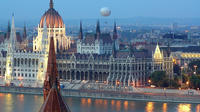Downtown Pest 3 Hour Private Tour with an Historian
Budapest, Hungary
Trip Type: Private Sightseeing Tours
Duration: 3 hours
This tour takes you through Budapest, the busy and lively centre of Budapest on the east bank of the river Danube. In the second half of the 19th century, Pest become the opulent political, financial and religious centre of the newborn Hungarian nation.
More About This Activity All Private Sightseeing Tours →
This tour takes you through Budapest, the busy and lively centre of Budapest on the east bank of the river Danube. In the second half of the 19th century, Pest become the opulent political, financial and religious centre of the newborn Hungarian nation.This tour takes you through Pest, the busy and lively centre of the city on the east bank of the river Danube. Since the Middle Ages, the castle of Buda on the west bank has always been the seat of royal power. But in the second half of the 19th become the opulent political, financial and religious centre of the newborn Hungarian nation. That development started in 1867, when Hungary regained most of its independence after a political compromise with the Austrian Hapsburg Empire to which the country belonged. Six years later, Buda and Pest were unified and from then the city started booming. They built a huge new Parliament, extravagant palaces for the Stock Exchange and banks, an immense new basilica, an impressive new Synagogue, the Andrassy út – an elegant boulevard modelled after the Champs Elysée in Paris, the first subway on the European continent, the Opera house, a river promenade, theatres and city parks.
The tour starts in front of the Parliament at Kossuth square. At its inauguration in 1896, it was the biggest and most costly structure ever built in Hungary and, an investment which still shows. Massive and impressive from the outside and dazzling within, it is brimming with art contributed by nearly every famous Hungarian painter and sculptor of the time. (We will not go inside, as Parliament organizes its own guided tours).
Of course, we take in and discuss the other buildings and monuments on and around the square, then visit the most impressive Holocaust Monument erected on a bank of the Danube right behind Parliament to memorialise the thousands of Jewish citizens of Budapest (a fourth of the city’s community) tragically killed on that very spot in the last months of the Second World War.
Freedom Square is our next stop. It was originally built as the financial centre of the city and according to many it is the most beautiful square in town. There is a lot to see here: the huge stock exchange palace and the opulent buildings that still house several banks, including the Hungarian National Bank. Interesting stories abound here: about the statue of American general Bentholz, about Cardinal Mindszenty, who lived hidden for 15 years in the US embassy while on the run for the communists, and the last Soviet monument, curiously flanked today by a the statue of Ronald Raegan put up in 2006.
We continue to St Stephen’s Basilica. Along the way, we will pass several beautiful art nouveau buildings for which Budapest is famous. A bit further is the Large Synagogue, the second largest synagogue in the world. It is a monument to the vital role the Jewish population (25% of the citizens of Budapest) and its wealthy bourgeois played in the development of the city. Eventually, we will travel along and under Andrassy Boulevard, an esplanade designed for nobility. After a short stop at the Opera House, the tour ends at Heroes Square.
The tour starts in front of the Parliament at Kossuth square. At its inauguration in 1896, it was the biggest and most costly structure ever built in Hungary and, an investment which still shows. Massive and impressive from the outside and dazzling within, it is brimming with art contributed by nearly every famous Hungarian painter and sculptor of the time. (We will not go inside, as Parliament organizes its own guided tours).
Of course, we take in and discuss the other buildings and monuments on and around the square, then visit the most impressive Holocaust Monument erected on a bank of the Danube right behind Parliament to memorialise the thousands of Jewish citizens of Budapest (a fourth of the city’s community) tragically killed on that very spot in the last months of the Second World War.
Freedom Square is our next stop. It was originally built as the financial centre of the city and according to many it is the most beautiful square in town. There is a lot to see here: the huge stock exchange palace and the opulent buildings that still house several banks, including the Hungarian National Bank. Interesting stories abound here: about the statue of American general Bentholz, about Cardinal Mindszenty, who lived hidden for 15 years in the US embassy while on the run for the communists, and the last Soviet monument, curiously flanked today by a the statue of Ronald Raegan put up in 2006.
We continue to St Stephen’s Basilica. Along the way, we will pass several beautiful art nouveau buildings for which Budapest is famous. A bit further is the Large Synagogue, the second largest synagogue in the world. It is a monument to the vital role the Jewish population (25% of the citizens of Budapest) and its wealthy bourgeois played in the development of the city. Eventually, we will travel along and under Andrassy Boulevard, an esplanade designed for nobility. After a short stop at the Opera House, the tour ends at Heroes Square.
« Go Back

